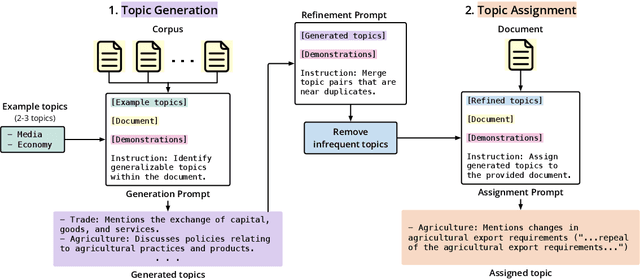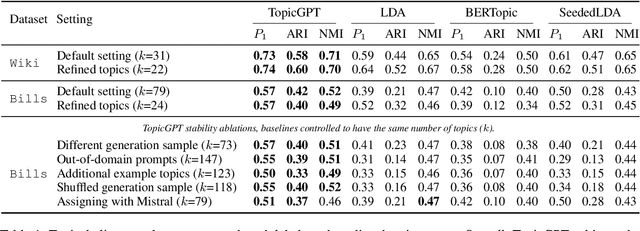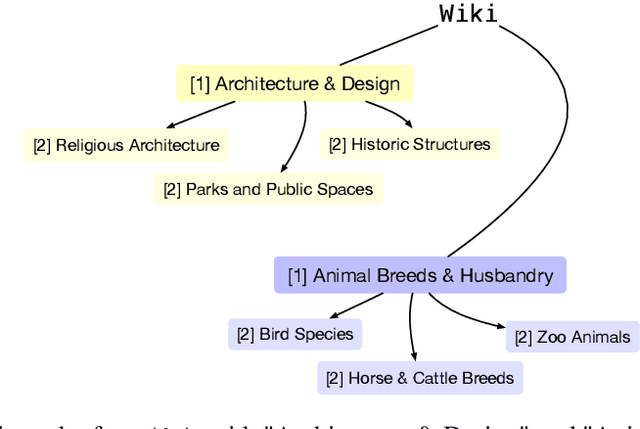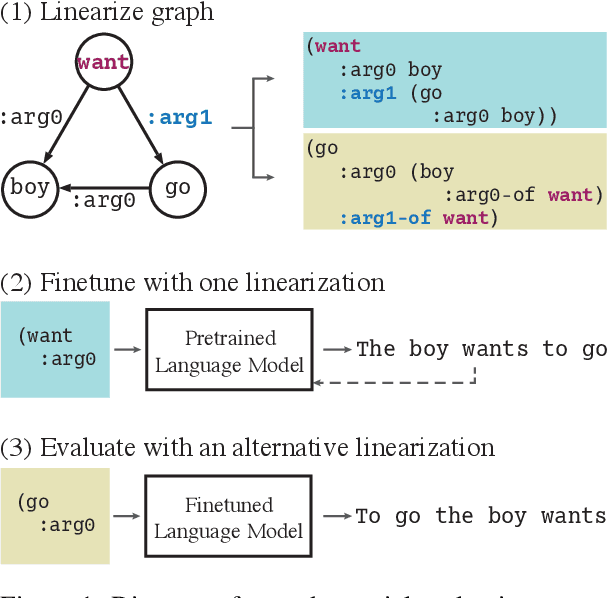Alexander Hoyle
Large Language Models Struggle to Describe the Haystack without Human Help: Human-in-the-loop Evaluation of LLMs
Feb 20, 2025Abstract:A common use of NLP is to facilitate the understanding of large document collections, with a shift from using traditional topic models to Large Language Models. Yet the effectiveness of using LLM for large corpus understanding in real-world applications remains under-explored. This study measures the knowledge users acquire with unsupervised, supervised LLM-based exploratory approaches or traditional topic models on two datasets. While LLM-based methods generate more human-readable topics and show higher average win probabilities than traditional models for data exploration, they produce overly generic topics for domain-specific datasets that do not easily allow users to learn much about the documents. Adding human supervision to the LLM generation process improves data exploration by mitigating hallucination and over-genericity but requires greater human effort. In contrast, traditional. models like Latent Dirichlet Allocation (LDA) remain effective for exploration but are less user-friendly. We show that LLMs struggle to describe the haystack of large corpora without human help, particularly domain-specific data, and face scaling and hallucination limitations due to context length constraints. Dataset available at https://huggingface. co/datasets/zli12321/Bills.
A SMART Mnemonic Sounds like "Glue Tonic": Mixing LLMs with Student Feedback to Make Mnemonic Learning Stick
Jun 21, 2024Abstract:Keyword mnemonics are memorable explanations that link new terms to simpler keywords. Prior works generate mnemonics for students, but they do not guide models toward mnemonics students prefer and aid learning. We build SMART, a mnemonic generator trained on feedback from real students learning new terms. To train SMART, we first fine-tune LLaMA-2 on a curated set of user-written mnemonics. We then use LLM alignment to enhance SMART: we deploy mnemonics generated by SMART in a flashcard app to find preferences on mnemonics students favor. We gather 2684 preferences from 45 students across two types: expressed (inferred from ratings) and observed (inferred from student learning), yielding three key findings. First, expressed and observed preferences disagree; what students think is helpful does not fully capture what is truly helpful. Second, Bayesian models can synthesize complementary data from multiple preference types into a single effectiveness signal. SMART is tuned via Direct Preference Optimization on this signal, which we show resolves ties and missing labels in the typical method of pairwise comparisons, augmenting data for LLM output quality gains. Third, mnemonic experts assess SMART as matching GPT-4, at much lower deployment costs, showing the utility of capturing diverse student feedback to align LLMs in education.
The Prompt Report: A Systematic Survey of Prompting Techniques
Jun 06, 2024Abstract:Generative Artificial Intelligence (GenAI) systems are being increasingly deployed across all parts of industry and research settings. Developers and end users interact with these systems through the use of prompting or prompt engineering. While prompting is a widespread and highly researched concept, there exists conflicting terminology and a poor ontological understanding of what constitutes a prompt due to the area's nascency. This paper establishes a structured understanding of prompts, by assembling a taxonomy of prompting techniques and analyzing their use. We present a comprehensive vocabulary of 33 vocabulary terms, a taxonomy of 58 text-only prompting techniques, and 40 techniques for other modalities. We further present a meta-analysis of the entire literature on natural language prefix-prompting.
TopicGPT: A Prompt-based Topic Modeling Framework
Nov 02, 2023



Abstract:Topic modeling is a well-established technique for exploring text corpora. Conventional topic models (e.g., LDA) represent topics as bags of words that often require "reading the tea leaves" to interpret; additionally, they offer users minimal semantic control over topics. To tackle these issues, we introduce TopicGPT, a prompt-based framework that uses large language models (LLMs) to uncover latent topics within a provided text collection. TopicGPT produces topics that align better with human categorizations compared to competing methods: for example, it achieves a harmonic mean purity of 0.74 against human-annotated Wikipedia topics compared to 0.64 for the strongest baseline. Its topics are also more interpretable, dispensing with ambiguous bags of words in favor of topics with natural language labels and associated free-form descriptions. Moreover, the framework is highly adaptable, allowing users to specify constraints and modify topics without the need for model retraining. TopicGPT can be further extended to hierarchical topical modeling, enabling users to explore topics at various levels of granularity. By streamlining access to high-quality and interpretable topics, TopicGPT represents a compelling, human-centered approach to topic modeling.
Making the Implicit Explicit: Implicit Content as a First Class Citizen in NLP
May 23, 2023Abstract:Language is multifaceted. A given utterance can be re-expressed in equivalent forms, and its implicit and explicit content support various logical and pragmatic inferences. When processing an utterance, we consider these different aspects, as mediated by our interpretive goals -- understanding that "it's dark in here" may be a veiled direction to turn on a light. Nonetheless, NLP methods typically operate over the surface form alone, eliding this nuance. In this work, we represent language with language, and direct an LLM to decompose utterances into logical and plausible inferences. The reduced complexity of the decompositions makes them easier to embed, opening up novel applications. Variations on our technique lead to state-of-the-art improvements on sentence embedding benchmarks, a substantive application in computational political science, and to a novel construct-discovery process, which we validate with human annotations.
Re-visiting Automated Topic Model Evaluation with Large Language Models
May 20, 2023Abstract:Topic models are used to make sense of large text collections. However, automatically evaluating topic model output and determining the optimal number of topics both have been longstanding challenges, with no effective automated solutions to date. This paper proposes using large language models to evaluate such output. We find that large language models appropriately assess the resulting topics, correlating more strongly with human judgments than existing automated metrics. We then investigate whether we can use large language models to automatically determine the optimal number of topics. We automatically assign labels to documents and choosing configurations with the most pure labels returns reasonable values for the optimal number of topics.
Are Neural Topic Models Broken?
Oct 28, 2022Abstract:Recently, the relationship between automated and human evaluation of topic models has been called into question. Method developers have staked the efficacy of new topic model variants on automated measures, and their failure to approximate human preferences places these models on uncertain ground. Moreover, existing evaluation paradigms are often divorced from real-world use. Motivated by content analysis as a dominant real-world use case for topic modeling, we analyze two related aspects of topic models that affect their effectiveness and trustworthiness in practice for that purpose: the stability of their estimates and the extent to which the model's discovered categories align with human-determined categories in the data. We find that neural topic models fare worse in both respects compared to an established classical method. We take a step toward addressing both issues in tandem by demonstrating that a straightforward ensembling method can reliably outperform the members of the ensemble.
Is Automated Topic Model Evaluation Broken?: The Incoherence of Coherence
Jul 05, 2021



Abstract:Topic model evaluation, like evaluation of other unsupervised methods, can be contentious. However, the field has coalesced around automated estimates of topic coherence, which rely on the frequency of word co-occurrences in a reference corpus. Recent models relying on neural components surpass classical topic models according to these metrics. At the same time, unlike classical models, the practice of neural topic model evaluation suffers from a validation gap: automatic coherence for neural models has not been validated using human experimentation. In addition, as we show via a meta-analysis of topic modeling literature, there is a substantial standardization gap in the use of automated topic modeling benchmarks. We address both the standardization gap and the validation gap. Using two of the most widely used topic model evaluation datasets, we assess a dominant classical model and two state-of-the-art neural models in a systematic, clearly documented, reproducible way. We use automatic coherence along with the two most widely accepted human judgment tasks, namely, topic rating and word intrusion. Automated evaluation will declare one model significantly different from another when corresponding human evaluations do not, calling into question the validity of fully automatic evaluations independent of human judgments.
Promoting Graph Awareness in Linearized Graph-to-Text Generation
Dec 31, 2020



Abstract:Generating text from structured inputs, such as meaning representations or RDF triples, has often involved the use of specialized graph-encoding neural networks. However, recent applications of pretrained transformers to linearizations of graph inputs have yielded state-of-the-art generation results on graph-to-text tasks. Here, we explore the ability of these linearized models to encode local graph structures, in particular their invariance to the graph linearization strategy and their ability to reconstruct corrupted inputs. Our findings motivate solutions to enrich the quality of models' implicit graph encodings via scaffolding. Namely, we use graph-denoising objectives implemented in a multi-task text-to-text framework. We find that these denoising scaffolds lead to substantial improvements in downstream generation in low-resource settings.
Improving Neural Topic Models using Knowledge Distillation
Oct 05, 2020



Abstract:Topic models are often used to identify human-interpretable topics to help make sense of large document collections. We use knowledge distillation to combine the best attributes of probabilistic topic models and pretrained transformers. Our modular method can be straightforwardly applied with any neural topic model to improve topic quality, which we demonstrate using two models having disparate architectures, obtaining state-of-the-art topic coherence. We show that our adaptable framework not only improves performance in the aggregate over all estimated topics, as is commonly reported, but also in head-to-head comparisons of aligned topics.
 Add to Chrome
Add to Chrome Add to Firefox
Add to Firefox Add to Edge
Add to Edge